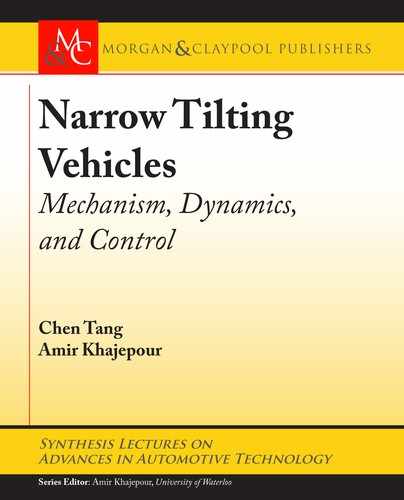4.7. HOLISTIC ENVELOPE CONTROL: MPC DESIGN EXAMPLE 53
4.7.2 ROLL CONSTRAINT ENVELOPE WITH MPC
To apply the above-mentioned safe envelope as state constraints in the controller design, the
model predictive control approach is adopted due to its straightforward implementation of the
constraints regarding the states and inputs in the form of Eq. (4.7). e predictive feature of the
controller also enables it to foresee the violation of the envelope and react at an early stage.
As shown in Section 4.7.1, a strict LTR constraint formulation could lead to an infeasible
problem since the use of tilting actuators always comes with the side-effect of decreased stability
in transient. However, if such LTR overshoot can be bounded, perturbation of the states outside
of the boundary allows the system to react more quickly for emergency conditions [70]. e slack
variable is thus introduced for a soft constraint formulation by allowing constraint violations but
minimizing them in the cost function against other control objectives. For implementations with
the MPC scheme, the following formulation for the slack variables in the prediction horizon
S
.k/
is adopted:
min
U;S
W J D
N
P
kD1
S
.
k
/
Q
p
s.t. W X
.
kC1
/
D AX
.
k
/
C BU
.
k
/
C EW
.
0
/
M X
.k/
C NU
.
k
/
L C S
.
k
/
S
.
k
/
0;
(4.19)
where
k
k
Q
p
denotes the norm-p of slack variables weighted by matrix Q, Matrix A; B; E rep-
resents general system matrices, while M; N; L denotes the roll envelope as derived in Eq. (4.7).
e cost of the slack variable should be minimized to avoid constraint violation in both
the magnitude as well as the duration, which are competing objectives for non-minimum phase
systems as described. e l
1
norm captures the worst-case constraint violation but does not
consider the duration of the violation time. It is also reported to have non-intuitive parameter
tuning issues as well as poor closed-loop performance [79]. e l
2
norm is chosen for the slack
variables in this research. Compared with the l
1
norm which linearly penalizes the constraint
violation, the l
2
norm better captures the demand to maintain the vehicle away from the “hard
boundary” for vehicle rollover conditions .LTR D ˙1/. It should be mentioned that the adoption
of l
1
or l
2
norm increases the computational burden, but it has been shown to be real-time
tractable [80] with the current hardware limitations.
With control objectives to maintain the vehicle within the safe roll envelope as well as
minimizing control efforts, an optimal receding horizon control is formulated as
..................Content has been hidden....................
You can't read the all page of ebook, please click here login for view all page.
